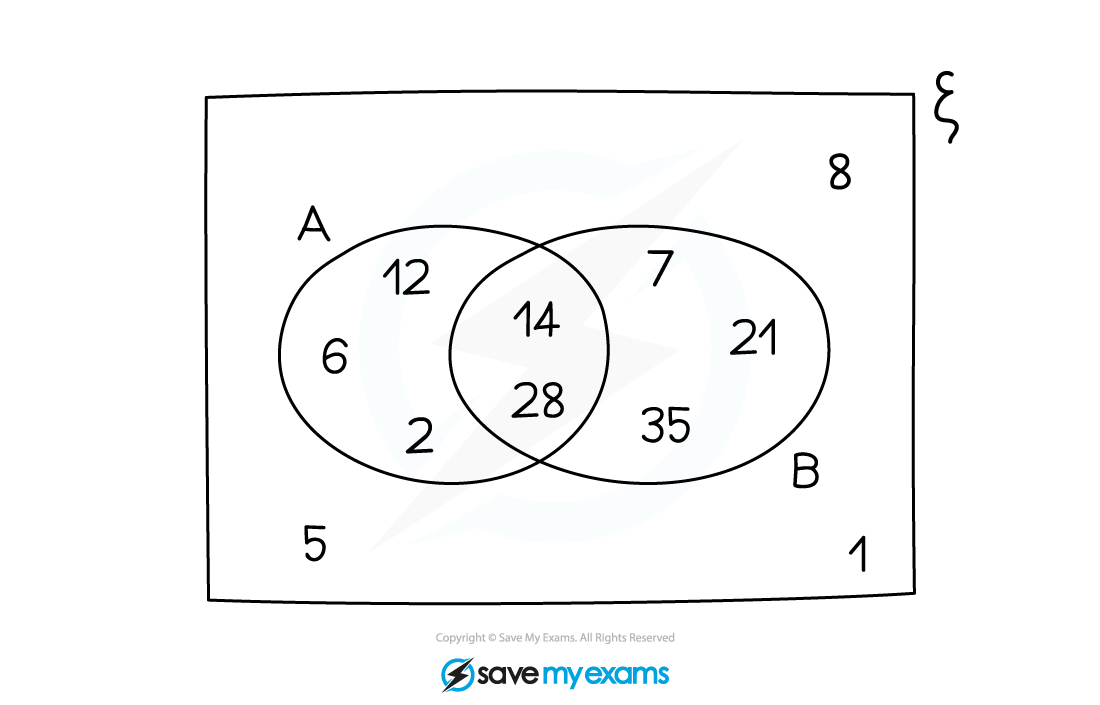Set Notation & Venn Diagrams (AQA GCSE Maths) : Revision Note
Did this video help you?
Set Notation
What is a set?
A set is a collection of elements
Elements could be anything
Numbers, letters, coordinates, ...
You could describe a set by writing its elements inside curly brackets {}
{1, 2, 3, 6} , is the set of factors of 6
If the set of elements follow a rule then you can write this using a colon inside the curly brackets {... : ...}
The bit before the colon is the type of element
The bit after the colon is the rule
{x is a positive integer : x2 < 30} is the set of positive integers which, when squared, are less than 30
This is equal to {1, 2, 3, 4, 5}
The colon is often read as 'such that'
If no type is specified, x can take any value (fractions, decimals, irrationals, ...)
{x: x2 < 30} means any value whose square is less than 30
{ (x, y) : y = mx + c } would mean the coordinates (x, y) where y = mx + c
I.e. The set of all possible coordinates that lie on the line y = mx + c
A colon can also be replaced by a vertical bar
{x | x2 < 30}
What do I need to know about set notation?
is the universal set (the set of everything)
For example, if we are only interested in factors of 24 then
= {1, 2, 3, 4, 6, 8, 12, 24}
You may see alternative notations used for
U is a common alternative (different to
for union!)
S or the Greek letter ξ (xi) may also be seen
We use upper case letters to represent sets (A, B, C, ...) and lower case letters to represent elements (a, b, c, ...)
means "is an element of"
E.g.
A
B means the intersection of A and B (the overlap of A and B)
This is the set of elements that are in both set A and set B
E.g. If A = {1, 2, 3, 4, 5} and B = {-1, 1, 4, 7, 8}, then A
B = {1, 4}
A
B means the union of A and B (everything in A or B or both)
This is the set of elements that are in at least one of the sets
This includes elements in both sets (in the intersection)
E.g. If A = {5, 6, 7, 8} and B = {3, 7, 11}, then A
B = {3, 5, 6, 7, 8, 11}
A' means the complement of A
It is the set of all elements in the universal set
that are not in A
E.g. If
= {1, 2, 3, 4, 5} and A = {1, 3}, A' = {2, 4, 5}
Did this video help you?
Venn Diagrams
What is a Venn diagram?
A Venn diagram is a way to illustrate all the elements within sets and any intersections
A Venn diagram consists of
a rectangle representing the universal set (
)
a circle for each set
Circles may or may not overlap depending on which elements are shared between sets
What do the different regions mean on a Venn diagram?
is represented by the region where the A and B circles overlap
is represented by the regions that are in A or B or both

How do I find probabilities from Venn diagrams?
Count the number of elements you want and divide by the total number of elements
For the Venn diagram shown below,
The probability of being in A is
There are 5 elements in A out of 11 in total
The probability of being in both A and B is
There are 2 elements in A and B (the intersection)
The probability of being in A, but not B, is
3 elements are in A but not B
Some harder questions are not out of the total number, but out of a restricted number
The probability of being in B, given that you are already in A, is
You are only interested in elements in A
There are 5 elements in A, out of which only 2 are also in B

Examiner Tips and Tricks
Be careful when filling in numbers for a Venn diagram
Some of the given numbers may need to be split between two sections of the Venn diagram
Suppose 10 people have a cat, 8 people have a dog and 6 people have both a cat and a dog
Out of the 10 people who have a cat
6 also have a dog
4 do not have a dog
Out of the 8 people who have a dog
6 also have a cat
2 do not have a cat
Worked Example
In a class of 30 students, 15 students study Spanish and 3 of the Spanish students also study German.
7 students study neither Spanish nor German.
(a) Draw a Venn diagram to show this information.
Draw the Venn diagram with its rectangular box and two (labelled) overlapping circles
3 students study both Spanish and German, so start here and work outwards
12 must study Spanish but not German (to get 15 in total for Spanish)
7 study neither, so this goes outside of the circles
To get 30 in total, 8 must study German but not Spanish

(b) Use your Venn diagram to find the probability that a student, selected at random from the class, studies Spanish but not German.
It helps to highlight Spanish but not German

Divide the number of students studying Spanish but not German by the total number of students
Students studying Spanish but not German = 12
Total number of students = 30
P(Spanish but not German)

You've read 0 of your 5 free revision notes this week
Sign up now. It’s free!
Did this page help you?
